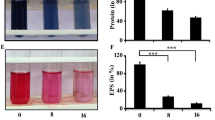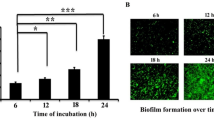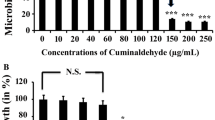Abstract
Pseudomonas aeruginosa often causes various acute and chronic infections in humans exploiting biofilm. Molecules interfering with microbial biofilm formation could be explored for the sustainable management of infections linked to biofilm. Towards this direction, the antimicrobial and antibiofilm activity of cuminaldehyde, an active ingredient of the essential oil of Cuminum cyminum was tested against Pseudomonas aeruginosa. In this regard, the minimum inhibitory concentration (MIC) of cuminaldehyde was found to be 150 μg/mL against the test organism. Experiments such as crystal violet assay, estimation of total biofilm protein, fluorescence microscopy and measurement of extracellular polymeric substances (EPS) indicated that the sub-MIC doses (up to 60 µg/mL) of cuminaldehyde demonstrated considerable antibiofilm activity without showing any antimicrobial activity to the test organism. Moreover, cuminaldehyde treatment resulted in substantial accumulation of cellular reactive oxygen species (ROS) that led to the inhibition of microbial biofilm formation. To this end, the exposure of ascorbic acid was found to restore the biofilm-forming ability of the cuminaldehyde-treated cells. Besides, a noticeable reduction in proteolytic activity was also observed when the organism was treated with cuminaldehyde. Taken together, the results demonstrated that cuminaldehyde could be used as a promising molecule to inhibit the biofilm formation of Pseudomonas aeruginosa.






Similar content being viewed by others
Availability of data and material
All data generated or analysed during this study are included in this article. The datasets generated during and/or analysed during the current study are available from the corresponding author on reasonable request.
References
Adonizio A, Kong KF, Mathee K (2008) Inhibition of quorum sensing-controlled virulence factor production in Pseudomonas aeruginosa by South Florida plant extracts. Antimicrob Agents Chemother 52:198–203
Bhattacharyya P, Agarwal B, Goswami M, Maiti D, Baruah S, Tribedi P (2018) Zinc oxide nanoparticle inhibits the biofilm formation of Streptococcus pneumoniae. Antonie Van Leeuwenhoek 111:89–99
Briviba K, Klotz LO, Sies H (1997) Toxic and signaling effects of photochemically or chemically generated singlet oxygen in biological systems. Biol Chem 378:1259–1265
Chakraborty P, Joardar S, Ray S, Biswas P, Maiti D, Tribedi P (2018) 3, 6-Di (pyridin-2-yl)-1, 2, 4, 5-tetrazine (pytz)-capped silver nanoparticles (TzAgNPs) inhibit biofilm formation of Pseudomonas aeruginosa: a potential approach toward breaking the wall of biofilm through reactive oxygen species (ROS) generation. Folia Microbiol 63:763–772
Chakraborty P, Dastidar DG, Paul P, Dutta S, Basu D, Sharma SR, Basu S, Sarker RK, Sen A, Sarkar A, Tribedi P (2020) Inhibition of biofilm formation of Pseudomonas aeruginosa by caffeine: a potential approach for sustainable management of biofilm. Arch Microbiol 202:623–635
Chakraborty P, Paul P, Kumari M, Bhattacharjee S, Singh M, Maiti D, Dastidar DG, Akhter Y, Kundu T, Das A, Tribedi P (2021) Attenuation of Pseudomonas aeruginosa biofilm by thymoquinone: an individual and combinatorial study with tetrazine-capped silver nanoparticles and tryptophan. Folia Microbiol (praha) 66:255–271
Chen Q, Hu X, Li J, Liu P, Yang Y, Ni Y (2011) Preparative isolation and purification of cuminaldehyde and p-menta-1,4-dien-7-al from the essential oil of Cuminum cyminum L. by high-speed counter-current chromatography. Anal Chim Acta 689:149–154
Clinical and Laboratory Standards Institute (2005) Performance standards for antimicrobial susceptibility testing: fifteenth informational supplement M100-S15. CLSI, Wayne
Cortes ME, Bonilla JC, Sinisterra RD (2011) Biofilm formation, control and novel strategies for eradication. Sci against Microbial Pathog Commun Curr Res Technol Adv 2:896–905
Das MC, Paul S, Gupta P, Tribedi P, Sarkar S, Manna D, Bhattacharjee S (2016) 3-Amino-4-aminoximidofurazan derivatives: small molecules possessing antimicrobial and antibiofilm activity against Staphylococcus aureus and Pseudomonas aeruginosa. J Appl Microbiol 120:842–859
Dubois M, Gilles KA, Hamilton JK, Rebers PT, Smith F (1956) Colorimetric method for determination of sugars and related substances. Anal Chem 28:350–356
Dwivedi S, Wahab R, Khan F, Mishra YK, Musarrat J, Al-Khedhairy AA (2014) Reactive oxygen species-mediated bacterial biofilm inhibition via zinc oxide nanoparticles and their statistical determination. PLoS ONE 9:e111289
Gambino M, Cappitelli F (2016) Mini-review: biofilm responses to oxidative stress. Biofouling 32:167–178
Gupta P, Sarkar S, Das B, Bhattacharjee S, Tribedi P (2016) Biofilm, pathogenesis and prevention-a journey to break the wall: a review. Arch Microbiol 198:1–15
Imlay JA (2003) Pathways of oxidative damage. Annu Rev Microbiol 57:395–418
Khatoon Z, McTiernan CD, Suuronen EJ, Mah TF, Alarcon EI (2018) Bacterial biofilm formation on implantable devices and approaches to its treatment and prevention. Heliyon 4(12):e01067
Lowry OH, Rosebrough NJ, Farr AL, Randall RJ (1951) Protein measurement with the folin phenol reagent. J Biol Chem 193:265–275
Mishra R, Panda AK, De Mandal S, Shakeel M, Bisht SS, Khan J (2020) Natural anti-biofilm agents: strategies to control biofilm-forming pathogens. Front Microbiol 11:566325
Monteiro-Neto V, de Souza CD, Gonzaga LF, da Silveira BC, Sousa NCF, Pontes JP, Santos DM, Martins WC, Pessoa JFV, Júnior ARC, Almeida VSS, de Oliveira NMT, de Araújo TS, Maria-Ferreira D, Mendes SJF, Ferro TAF, Fernandes ES (2020) Cuminaldehyde potentiates the antimicrobial actions of ciprofloxacin against Staphylococcus aureus and Escherichia coli. PLoS ONE 15:e0232987
Mukherjee K, Tribedi P, Mukhopadhyay B, Sil AK (2013) Antibacterial activity of long-chain fatty alcohols against mycobacteria. FEMS Microbiol Lett 338:177–183
Paul P, Chakraborty P, Chatterjee A, Sarker RK, Dastidar DG, Kundu T, Sarkar N, Das A, Tribedi P (2021) 1, 4-Naphthoquinone accumulates reactive oxygen species in Staphylococcus aureus: a promising approach towards effective management of biofilm threat. Arch Microbiol 203:1183–1193
Roy R, Tiwari M, Donelli G, Tiwari V (2018) Strategies for combating bacterial biofilms: a focus on anti-biofilm agents and their mechanisms of action. Virulence 9:522–554
Sharma D, Misba L, Khan AU (2019) Antibiotics versus biofilm: an emerging battleground in microbial communities. Antimicrob Resist Infect Control 8:76
Sowbhagya HB (2013) Chemistry, technology, and nutraceutical functions of cumin (Cuminum cyminum L): an overview. Crit Rev Food Sci Nutr 53:1–10
Tariq S, Wani S, Rasool W, Shafi K, Bhat MA, Prabhakar A, Shalla AH, Rather MA (2019) A comprehensive review of the antibacterial, antifungal and antiviral potential of essential oils and their chemical constituents against drug-resistant microbial pathogens. Microb Pathog 134:103580
Tribedi P, Sil AK (2014) Cell surface hydrophobicity: a key component in the degradation of polyethylene succinate by Pseudomonas sp. AKS2. J Appl Microbiol 116:295–303
Wimpenny J, Manz W, Szewzyk U (2000) Heterogeneity in biofilms. FEMS Microbiol Rev 24:661–671
Yang L, Hu Y, Liu Y, Zhang J, Ulstrup J, Molin S (2011) Distinct roles of extracellular polymeric substances in Pseudomonas aeruginosa biofilm development. Environ Microbiol 13:1705–1717
Acknowledgements
The authors would like to thank Ms. Ahana Chatterjee for critically reading the manuscript. We are extremely grateful to Dr. Debasish Maity (Professor, Department of Human Physiology, Tripura University, India) for sharing the organism with us to carry out our research activities.
Funding
Not applicable.
Author information
Authors and Affiliations
Contributions
SC, PP, PC, SD, RKS performed the experiments and wrote the manuscript. SS analysed the results and wrote the manuscript. AD and PT conceived the idea, designed the experiments, analysed the results and edited the manuscript critically.
Corresponding authors
Ethics declarations
Conflict of interest
Authors declare that they do not have any conflict of interest.
Ethics approval and consent to participate
Not applicable.
Consent for publication
Not applicable.
Rights and permissions
About this article
Cite this article
Chatterjee, S., Paul, P., Chakraborty, P. et al. Cuminaldehyde exhibits potential antibiofilm activity against Pseudomonas aeruginosa involving reactive oxygen species (ROS) accumulation: a way forward towards sustainable biofilm management. 3 Biotech 11, 485 (2021). https://doi.org/10.1007/s13205-021-03013-1
Received:
Accepted:
Published:
DOI: https://doi.org/10.1007/s13205-021-03013-1




